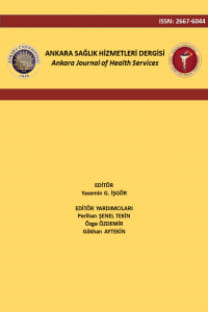Geriatrik bilateral transfemoral amputede stubbies denemesi
Bilateral alt ekstremite amputasyonları içerisinde transfemoral amputasyonlar nadir görülür ve nedenleri çoğunluklu diyabete bağlı vasküler hastalıklar ve travmadır. Geriatrik bilateral amputeler rehabilitasyon ekibinin ciddi mücadelesini gerektirir ve prostetik rehabilitasyon sürecini geciktirir
Anahtar Kelimeler:
Transfemoral ampute, stubby, geriatrik ampute, rehabilitasyon, protez
Geriatrik Bilateral Transfemoral Amputede Stubbies Denemesi
Bilateral transfemoral amputations are rarely in lower extremity amputations. The most common causes diabetic vascular disease and trauma. Geriatric bilateral amputees require the serious challenges of the rehabilitation team and delay the prosthetic rehabilitation
Keywords:
Transfemoral amputee, stubby, geriatric amputee, rehabilitation, prosthesis,
___
- Balakrishnan A. Technical note-tilting stubbies. Prosth and Orth International, 5: 85-87, 1981.
- Bowers R. Standing alone again: bilateral above-knee amputee gets help from others to regain his in dependence and joy. In Motion. 2008; 18: 52-55.
- Carroll K, Richardson R. Improving out comes for bilateral transfemoral amputees: A graduated approach to prosthetic success. The Academy Today, Online Learning Centre, 2009; 5(2).
- Crouse SF, Lessard CS, Rhodes J, Lowe RC, Oxygen consumption and cardiac response of short-leg and long- leg prosthetic ambulation in a patient with bilateral above-knee amputation: Comparison with able-bodied men. Arch Pyhs Med Rehab 1990; 71: 313-317.
- Engstrom B, Van de Ven C. Physiothrapy for Amputees. London, Churchill Livingstore, 1985.
- Gitter A, Paynter K, Walden G, et al. In fluence of rotators on the kinematic adaptations in stubby prosthetic gait. Am J Phys Med Rehabil, 2002; 81(4): 310-314.
- Hoffman MD, Sheldahl LM, Buley KJ and Sandford PR. Physilogical comparison of walking among bilateral above-knee amputee and able-bodied subjects, and a model to account for differences in metabolic cost. Arch Phys Med Rehab, 78: 385-392, 1997.
- Karmarkar AM, Collins DM, Wichman T, Franklin A et al. Prosthesis and wheelchair use in veterans with lower-limb amputation. Journal of Rehab Research and Development, 46(5): 567-576, 2009.
- Kruger LM: Stubby prostheses in the rehabilitation of infants and small children with bilateral lower limb deficiencies. Rehabilitation, 1990; 29: 12-15.
- Manella KJ. Comparing the effectiveness of bandages and shrinker socks for lower extremity amputees. Phy Ther 61: 334-337, 1981.
- May BJ. Amputation and Prosthetics. Philadelphia, Davis Co, 1996.
- Mc Colough NC, Harris AR, Hampton FL: The bilateral lower-limb amputee, In: Atlas of Limb Prosthetics, Surgical and Prosthetic Principles. Ed: Burgess EM. CV Mosby, St.Louis, 1981, pp. 417-422.
- Smith DG, Burgess EM and Zett JH. Special Considerations: Fitting and training the bilateral lower limb amputee. In: Atlas of Limb Prosthetics: Surgical, Prosthetic and Rehab Principles, Eds: JH Bowker, JH Michael. 2nd ed, CV Mosby, St Louis, 1992, pp. 599-623.
- Uellendahl JE, Bilateral lower limb prostheses. In: Atlas of Amputations and Limb Deficiencies: Surgical Prosthetics and Rehabilitation Principles, Eds: DG Smith, JW Michael, JH Bowker. Rosemont, 3rd ed, IL, 2004, pp. 621-632.
- Wainapel SF, March H, Steve L: Stubby prostheses: An alternative to conventional prosthetic devices. Arch Phys Med Rehab 1985; 66: 264-266.
- Whitehouse FW, Jurgensen C, Block MA: The later life of the diabetic amputee: Another look at the fate of the second leg. Diabetes 1968; 17: 520.
- Yayın Aralığı: Yılda 2 Sayı
- Başlangıç: 2000
- Yayıncı: Ankara Üniversitesi
Sayıdaki Diğer Makaleler
Geriatrik bilateral transfemoral amputede stubbies denemesi
Serap ALSANCAK, Haydar ALTINKAYNAK, Senem GÜNER
Otofaji: Programlı Hücre Ölümü
Aslı KOÇ, Arzu Zeynep KARABAY, Tülin ÖZKAN, Zeliha BÜYÜKBİNGÖL, Asuman SUNGUROĞLU, Fügen AKTAN
Türk edebiyatından yas teması örnekleri
Gülbahar BAŞTU, E.tuğba ÖZEL-KIZIL, Yasemin HOŞGÖREN ALICI, Sevinç KIRICI
Bilişsel rezerv ve yaşlanan beyin
Gülbahar BAŞTUĞ, E. Tuğba ÖZEL-KIZIL
Buket ALTINOK, Asuman SUNGUROĞLU
Aslı KOÇ, Arzu Zeynep KARABAY, Tülin ÖZKAN, Zeliha BÜYÜKBİNGÖL, Asuman SUNGUROĞLU, Fügen AKTAN
